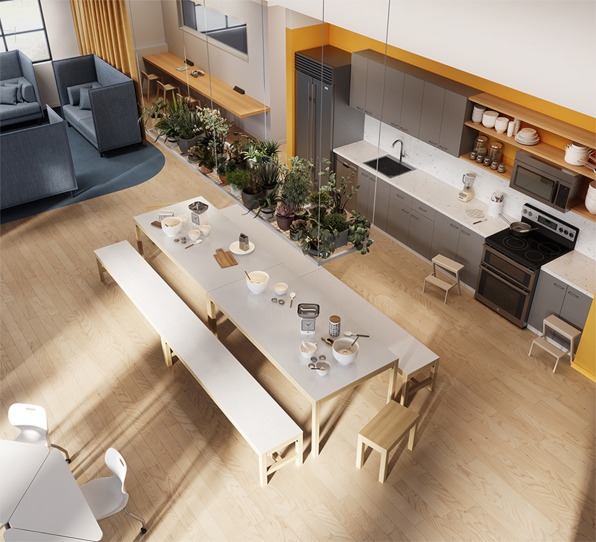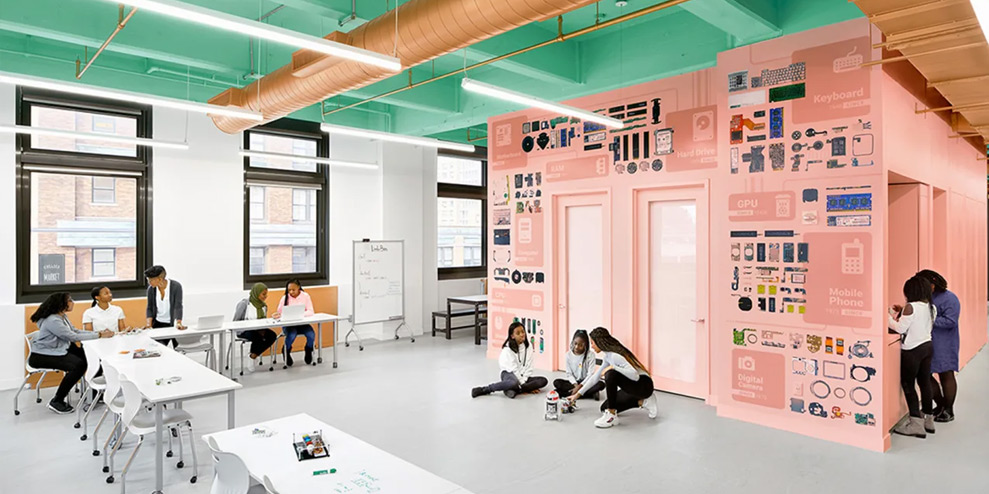Offices around the U.S. are sitting empty, as the pandemic has forced many employees to work from home. Some of these offices will eventually come back to life, but others may lay fallow indefinitely. But, as one project in California shows, they don’t have to fall completely out of use. A formerly vacant office building there has been converted into a new school.
The office-to-school conversion was designed by architect Danish Kurani, who has developed a specialization in converting commercial buildings into innovative new educational facilities. In 2019, his firm converted a vacant office building in the San Francisco suburb of Livermore into the new home of Acton Academy East Bay, an affiliate of the Austin-based private school Acton Academy. The Livermore version of the school is showing how underutilized office spaces can take on different forms to meet changing demands. As the pandemic adjusts many companies’ expectations about their future office needs, these kinds of reuse projects may be a way to give emptying commercial real estate a new life.

It’s an environmentally friendly form of development, Kurani says, since it takes advantage of space already built and sidesteps the need for the resource-intensive materials required for constructing a building from scratch. It’s also an economically flexible option for small and startup organizations, especially schools.“For these micro-schools and startup schools, being able to do adaptive reuse gives them a fighting chance,” Kurani says. “Real estate is the barrier to entry. So by being able to take what’s there and make the most of it, you really give these types of programs a chance to get off the ground.”

The school Kurani designed was a fairly simple adaptation of the office building. At a relatively compact 3,600 square feet, the building was already subdivided into several private offices, which fit well with the various classroom needs of the school and enabled the design to function with the existing plumbing and electrical infrastructure. To increase the size of some rooms and improve connections, Kurani tore down a few walls and added new windows to increase natural light.These small changes also created some new opportunities. After the walls were demolished, Kurani reused some of the former offices’ doors and windows as material for other parts of the project, like desks and bookshelves.
These are tricks he’s picked up in previous projects converting commercial spaces to learning environments, like the Khan Lab School built in a former office building in Mountain View, California, and the Black Girls Code Lab, a tech-focused learning space built inside a Google office building in New York. Adapting a former office into a learning environment isn’t a huge stretch, he says. It also has the added benefit of bringing kids into closer contact with the community.
“There’s something about the way that schools and learning centers are currently done in most of America, where they feel so isolated and detached from the rest of society, especially in suburbia,” Kurani says. “When we do these learning spaces where we’ve done some adaptive reuse, it actually helps the learning get closer to reality. The kids are closer to the real world, they’re less isolated, they’re near adults who are going to work.”
This kind of office space reuse may start to become more commonplace as companies reconsider their needs and remote working leads to smaller offices. Kurani says it won’t just be schools, but other kinds of community- and youth-focused uses that can take over and keep these buildings from sitting empty.
“Obviously with COVID, it’s helped companies realize they can get by with less commercial real estate, so there’s going to be plenty of vacancy in office spaces,” Kurani says. “So it would be good to figure out what [are]the highest-value things we can put in those spaces.”
This article first appeared in www.fastcompany.com



